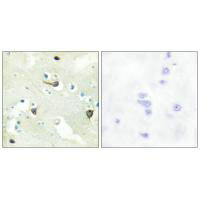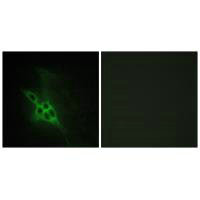
Immunohistochemistry analysis of paraffin-embedded human brain tissue using EPHB1/2/3 antibody.
EPHB1/EPHB2/EPHB3 Antibody
CSB-PA106334
ApplicationsImmunoFluorescence, ELISA, ImmunoHistoChemistry
Product group Antibodies
ReactivityHuman, Mouse
TargetEPHB1
Overview
- SupplierCusabio
- Product NameEPHB1/EPHB2/EPHB3 Antibody
- Delivery Days Customer20
- ApplicationsImmunoFluorescence, ELISA, ImmunoHistoChemistry
- CertificationResearch Use Only
- ClonalityPolyclonal
- ConjugateUnconjugated
- Gene ID2047
- Target nameEPHB1
- Target descriptionEPH receptor B1
- Target synonymsEK6; ELK; eph tyrosine kinase 2; EPH-like kinase 6; ephrin type-B receptor 1; EPHT2; Hek6; NET; neuronally-expressed EPH-related tyrosine kinase; soluble EPHB1 variant 1; tyrosine-protein kinase receptor EPH-2
- HostRabbit
- IsotypeIgG
- Protein IDP54762
- Protein NameEphrin type-B receptor 1
- Scientific DescriptionReceptor tyrosine kinase which binds promiscuously transmembrane ephrin-B family ligands residing on adjacent cells, leading to contact-dependent bidirectional signaling into neighboring cells. The signaling pathway downstream of the receptor is referred to as forward signaling while the signaling pathway downstream of the ephrin ligand is referred to as reverse signaling. Cognate/functional ephrin ligands for this receptor include EFNB1, EFNB2 and EFNB3. During nervous system development, regulates retinal axon guidance redirecting ipsilaterally ventrotemporal retinal ganglion cells axons at the optic chiasm midline. This probably requires repulsive interaction with EFNB2. In the adult nervous system together with EFNB3, regulates chemotaxis, proliferation and polarity of the hippocampus neural progenitors. Beside its role in axon guidance plays also an important redundant role with other ephrin-B receptors in development and maturation of dendritic spines and synapse formation. May also regulate angiogenesis. More generally, may play a role in targeted cell migration and adhesion. Upon activation by EFNB1 and probably other ephrin-B ligands activates the MAPK/ERK and the JNK signaling cascades to regulate cell migration and adhesion respectively. Tang X.X., Genomics 29:426-437(1995). Zhang Z., Protein Sci. 13:2819-2824(2004). Stein E., J. Biol. Chem. 271:23588-23593(1996).
- ReactivityHuman, Mouse
- Storage Instruction-20°C or -80°C
- UNSPSC12352203

